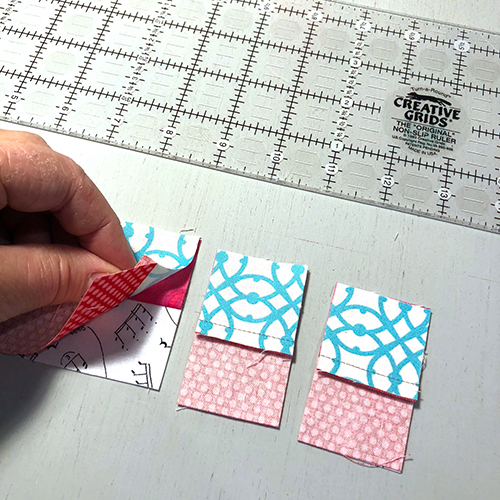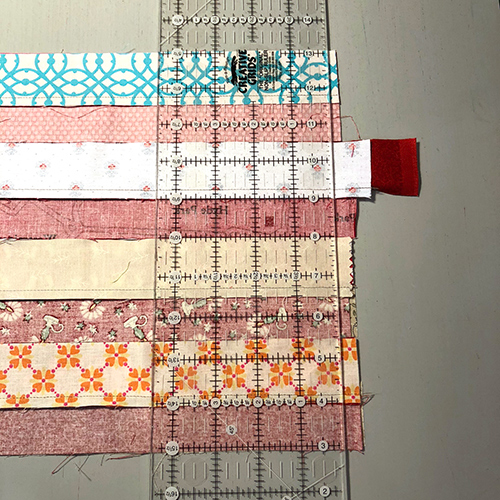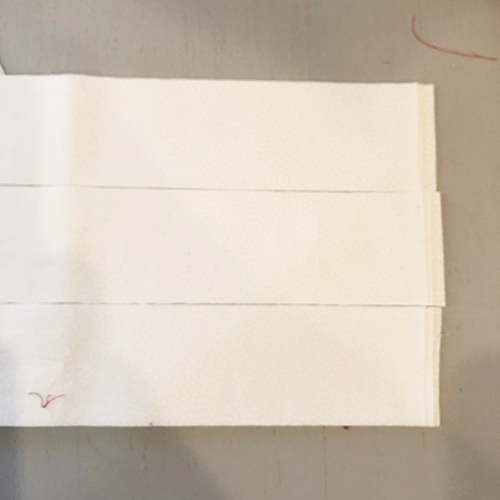A friend and I were sewing together the other day, and we both noticed a few things that we do differently from each other. My pal commented on the speediness of my method for cutting units from strip sets, so I wanted to share it with you.

When you make a strip set, above, you can cut the units from one strip just one at a time, as shown below.

But most of us quickly realize that this doesn’t go quickly.

If you’re making Four Patches, you can layer two strip sets together as shown above. I think that maybe Bonnie Hunter of Quiltville fame was the first one to introduce this idea to me. It’s wicked smart.

As you cut the units from the strip sets, they’re all matched up and ready to sew together just as they are.

Somewhere along the way, I wondered why I couldn’t cut several of these layered strip sets at once. Above you can see three sets layered up. I scootch them close together and line everything up as straight as I can.

Here you can see how they’re all very close to each other, actually touching along the raw edges.

I use the lines on my ruler to check if everything is straight. I nudge them into position so that the top raw edges line up perfectly with the ruler, as well as the bottom edges, and several places in between. The seams are also a good place to use for lining things up. The raw edges and seams don’t need to be exactly ON a line, but they need to run parallel to a line.

Once everything is nice and even, I cut across all of the strip sets at once to get my units. You can see above that I had to stop and true up once roughly in the middle, and that’s perfectly fine to do.
With every cut, I got four sets of patches to sew into a Four Patch. That’s eight times more than I’d get if I cut them one at a time. This increases the speed of the whole process by a lot, and we all want to get through the cutting so that we can start to enjoy the piecing, right?!

I use the same system when I’m cutting patches from strips, above. I left a little space between them so you can see there are three sets of strips. There are four layers in each set.

Once again I scoot them all very close together and use my ruler to be sure everything is lined up.

Then I cut the patches from all of the strips at once. So in this example, just one cut yields 12 patches. It’s pretty efficient.
When you make your first cut, it’s easier to rotate the mat than to move all of the layers of strip sets or strips before making the rest of the cuts. I don’t use a rotating mat for this though, because the one I have isn’t large enough to accommodate the process.
If you’re able to use a rotary cutter with either hand (as I am), then you never have to move the strips at all. If you’re even slightly ambidextrous, consider learning to cut with both hands. It’s amazing how much time and effort it saves.

What a great tip. Thanks!
It’s my pleasure, Gail. 🙂
Such awesome tips for speedy cutting and accurate also. Good to know this can be done without wonky cuts. Thank you for the tips.
Love this tip! I have cut strip sets layered, but I have never butted up multiples like that. Great idea that I will be using in the future. Thanks!
Thanks, Mary Beth!
Thank you so much for this hint. I love love making quilts and I catch myself counting how many pieces I have to cut to make the
quilt. I really hate cutting all those pieces. If I know where you are, I would hug your neck.
Thank you again.
Carolyn in Pensacola, Florida
Hi Carolyn, I’m glad to hear this will be helpful. If I were in Florida, I’d hug you back! 🙂
Obrigada ótima aula
Love this!